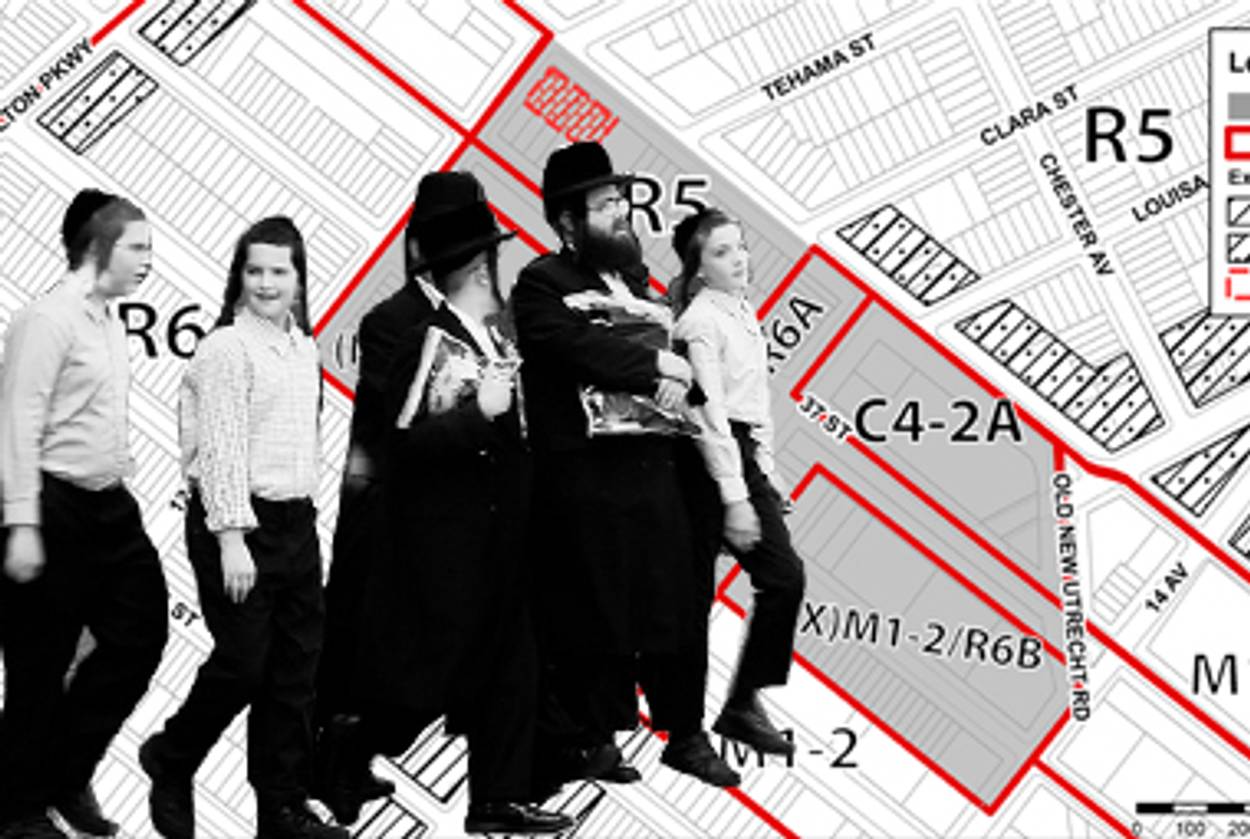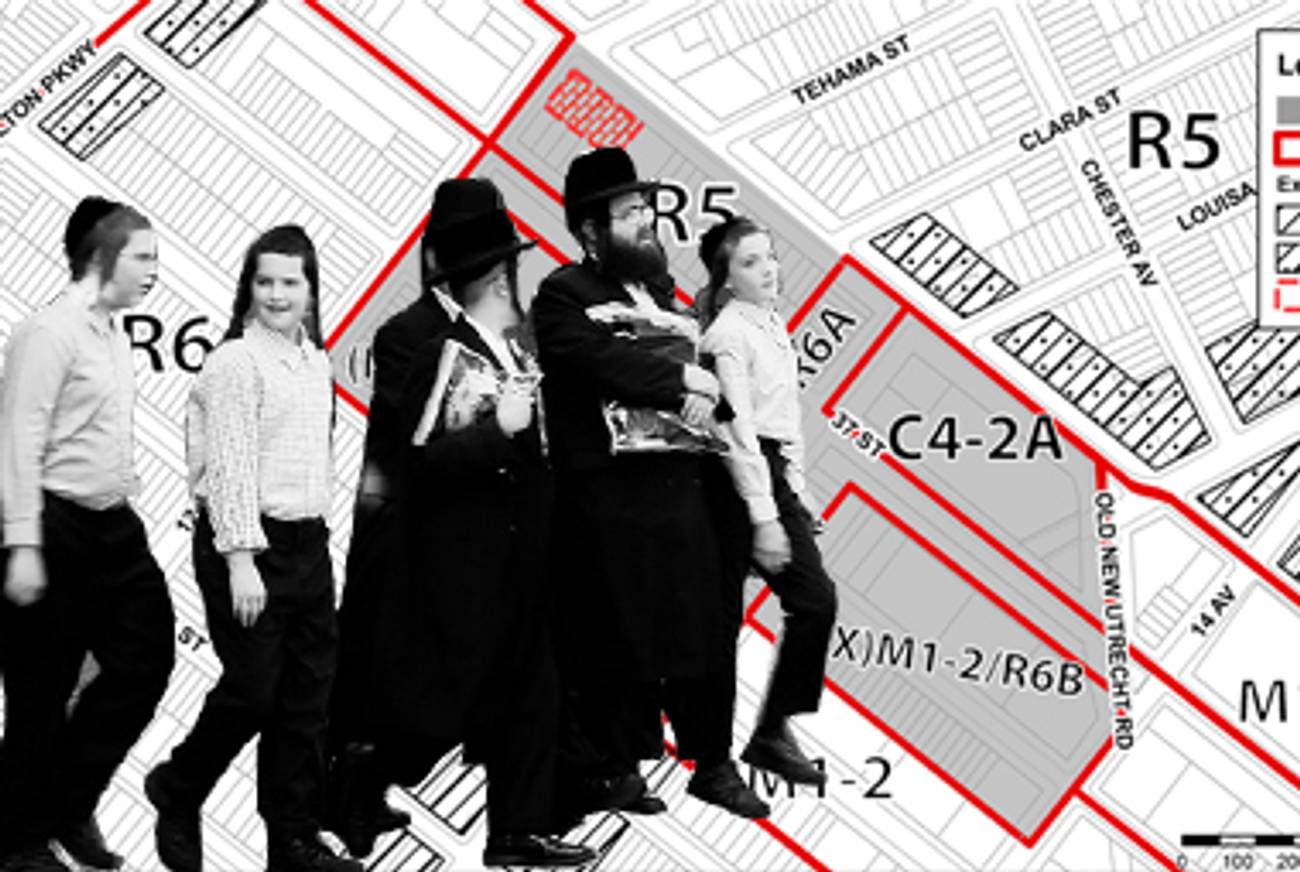Home Front
Is it wrong to build publicly subsidized housing designed for New York’s ultra-Orthodox community?




Nothing could be more mundane than a construction site in the ever-changing landscape of urban territory. But in one Brooklyn neighborhood, what might have been a simple case of tailoring supply to prospective buyers’ demands has kicked up a larger question about the future of Orthodox Jewish living in New York City.
Last Wednesday, the New York City Council voted to approve an eight-block rezoning that holds as its centerpiece a proposed 17 buildings of affordable housing. Known as the Culver El Estates, the plan includes 68 apartment units to be built by the Orthodox Jewish community that inhabits the area, Borough Park. Unlike most of New York City’s 178,000 public housing units, which average two bedrooms, a majority of the units at Culver El will consist of four- or five-bedroom apartments—intentionally large dwellings to fit the family size of the ultra-Orthodox.
The developer of the Culver El project is the South Brooklyn Community Organization, an arm of the umbrella Hasidic organization Agudath Israel, which, according to a spokesman, has developed more than 300 affordable housing units in New York—most of which have been heavily subsidized by federal or state funds. But this new rezoning initiative, some non-Orthodox residents claim, arrived abruptly, with little word of its development outside the insular Orthodox community, even though it occupied a large, central location in an ethnically diverse neighborhood.
“It’s built for a population―a subset of the population―in the neighborhood,” said area resident Liena Zagare, who blogs about the neighborhood at The Kensington Prospect. “That doesn’t seem right.”
Of the 130,000 families on the waiting list for public housing apartments, according to the city’s Housing Authority, only half a percent request four or more bedrooms, which cost $523 a month in Brooklyn. (Most applicants are waiting for studio apartments with rents starting at $288 a month.) Of course, the number of rooms in a housing-project unit is not alone an indicator of discrimination, and the gaudiest Borough Park abodes are still dwarfed by the towering apartments of Manhattan elites. But in the current tight housing market, large apartments designed for a certain community’s lifestyle can be enough to bring the case to court and test the political muscle of well-organized and connected Orthodox groups.
According to the people behind the Culver El development, the arrival of the project was anything but abrupt. For them, it was a long march through the bureaucratic machinery and neighborhood politics of New York, dating back to 2001, when they brought their proposal to the district’s city councilman. Before then, Orthodox housing projects in the city had met very little resistance.
***
Even by urban standards, Borough Park contains an exceptionally high population density. The maternity ward at the Maimonides Medical Center, in the heart of the neighborhood, delivers more babies than any other hospital in the state.
A report, released last year by New York University’s Furman Center for Real Estate and Urban Policy, identified the neighborhood as one of the city’s most “severely crowded.” But Borough Park is also home to the largest concentration of Jews in the United States, a highly observant Orthodox community that clusters its housing around synagogues. The community’s growth has been at the root of a wave of construction projects that has transformed the shape and texture of the neighborhood, pushing the metric known as “median rent burden,” or the fraction of income spent on housing, there to first in Brooklyn, while its income lags behind the rest of the borough.
These pressures—crowding, high prices, and exceptional religious needs—have forced many Orthodox families out of the neighborhood to New Jersey and suburbs elsewhere in New York State, where they aren’t always welcome. Transplanted Orthodox families—in towns upstate and on Long Island—have faced hostile disputes with local populations over housing, said Steven I. Weiss of The Jewish Channel, which regularly covers housing issues. In 2000, the city council in Tenafly, New Jersey, voted to prohibit lechis, the posts ultra-Orthodox use to form an eruv, a physical enclosure, on the Sabbath. Orthodox Jews ran into similar hurdles in the Hamptons, where, two summers ago, residents vigorously opposed construction of an eruv. In the Town of Ramapo, a suburban hamlet in Rockland Couty, New York, locals were irate when new Orthodox residents successfully lobbied for revisions to local zoning laws. “You wonder,” one woman asked The New York Times, “how can someone drop their own little planet on us?”
So far, these tensions have stayed outside New York City’s borders. But as the Orthodox population grows, that may be changing.
“There is no long-term, broad-based disregard for Orthodox neighbors anywhere in Brooklyn akin to what we’ve seen in some American suburbs,” Weiss said. Orthodox residents in Borough Park are a well-established part of the fabric of New York City life, and these housing projects are extensions of their community’s needs. The developers see themselves as the premier providers of affordable housing in their areas and natural advocates for the ultra-Orthodox, who make up an overwhelming majority of the Jewish residents in the neighborhood. By and large, city agencies, particularly under the pro-development Bloomberg Administration, agree. And city officials—eager to attach their names to any affordable housing project—willingly accommodate the particular housing requests of this rapidly growing population that votes in big, organized blocs.
Even if this voting dynamic does not hold, particularly with younger, more independent Orthodox voters, it’s still the reigning conventional wisdom. “I think it’s perceived to be a well-organized vote, and I think politicians respond to well-organized votes,” John Mollenkopf, a political science professor at the City University of New York, recently told The Forward. For Orthodox leaders pushing political initiatives in the city, success depends on keeping their numbers high.
Over the past two decades, housing developments in Borough Park have sprouted as rapidly as the population, and most projects are completed swiftly. In 1992, the city created a special ordinance for the neighborhood that relaxed zoning restrictions, allowing buildings to expand to cover 65 percent of their lot in high-density areas. Between 1996 and 2003, the average number of new housing permits issued in Borough Park was nearly five times greater than in neighboring districts. For the ambitious Culver El development, South Brooklyn Community Organization got subsidies from the New Foundations Program, New York City’s 2000 initiative to promote homeownership. Under the program, city-owned property is doled out to private developers who promise a third of the units—handed out via lottery—will meet certain affordability standards. (SBCO said Culver El will have apartments available for families that make roughly $50,000 to $90,000 a year.) City subsidies are repaid by the developer over time, with incentives built in for occupancy. To alert local residents to the newly available housing, developers are required to advertise in one of the city’s metro dailies, a community paper, and what the law calls an “ethnic newspaper.”
In 2005, Michael Bloomberg officially announced the Borough Park rezoning plan that paved the way for Culver El Estates. And on May 12, 2010, the development won the approval of the city’s Planning Department. A month later, the community board approved, with only two members objecting. One of those no votes was from Maggie Tobin, who lives near the project and said the rezoning squanders a chance to create more open space in the densely populated neighborhood. (The rezoning plan passed in the City Council allocated $600,000 to renovate the nearest park and expand open spaces.) “If there’s enough room for 68 units,” she told me, “it pretty much sounds like there’s going to be a lot of kids there. You can do the math.”
***
The Culver El project is not even the only Brooklyn site causing controversy for this reason. A few miles north, in the Williamsburg neighborhood, a development of 1,895 units of mixed-income housing, known as Broadway Triangle, is facing legal hurdles. Unlike the publicly subsidized, privately built Culver El project, Broadway Triangle is a proposal of the city’s Housing Authority, which administers all the public housing in the five boroughs.
The United Jewish Organization of Williamsburg, a Hasidic service agency with close ties to local Assemblyman Vito Lopez, Brooklyn’s county Democratic leader, won the development rights to Broadway Triangle. UJO secured the development without competitive bids, a rare maneuver that did not go unchallenged. Several local Latino and African-American churches and nonprofits partnered with two area Orthodox organizations, the Central Jewish Council and United Jewish Community Advocacy Relations and Enrichment, to actively oppose the development. The group, called the Broadway Triangle Coalition, has worked primarily with the aid of Brooklyn Legal Services to mount legal challenges to UJO’s project. The building’s apartment sizes and layout—with most apartments, especially those on the lower floors not requiring use of a Sabbath elevator, counting four bedrooms or more—favor the Orthodox, this group claims, and are tantamount to discrimination. If the city is going to offer “affordable housing,” the group argues, then it should be affordable to everyone.
But the main objection to the project is political, explained Martin Needelman of Brooklyn Legal Services. “It’s not just the division of the apartments,” he said of motivation for the lawsuit,” but the process that led up to it that excluded every group that is not aligned with the UJO.”
Last December, the New York City Council approved the Broadway Triangle project by a 36-10 vote. Immediately after the vote, the coalition filed a discrimination lawsuit in a State Supreme Court in Manhattan. Justice Emily Jane Goodman upheld the suit, issuing an injunction to halt the development’s construction. And on May 20, Goodman blocked an attempt to have the suit thrown out. “With such negligible demand for large apartments as compared with smaller ones,” wrote Goodman, “it is questionable why in such a daunting housing crisis, there is so powerful a commitment, with funds, to construct only large, and, therefore, fewer, apartments.” In June, the coalition rejected an offer by the city to settle the lawsuit. Then, on October 13, Goodman suspended the suit in response to a pending federal investigation of Lopez and his nonprofits, an inquiry that will seriously hamper the development from moving forward. So goes the turf war, in court battles and counter-accusations, gaining and giving ground one project at a time.
***
This past August, Rabbi Chaim Israel, the housing development director for the South Brooklyn Community Organization, showed me the Culver El site. Bodegas nestled beside Bangladeshi bazaars and kosher markets in the close-packed storefronts. Standing across from his development’s future home, Israel described the situation as he saw it. “Large families are living with a very unique problem,” he said. “No one wants to rent to large families.” He pointed out another housing project managed by SBCO four blocks away. The units, built nearly two decades ago, still had 95 percent of the original homeowners, he claimed proudly. With Culver El, he wants to invite those formerly denied the opportunity to “join the homeowning society.” When pressed, though, Israel batted away assumptions that units would go exclusively to Orthodox Jews. “They will,” he said of the neighbors hailing from Pakistan, Mexico, Bangladesh, and elsewhere, “have the opportunity to buy just like anybody else.”
Mark Bergen writes about public policy and lives in Chicago.
Mark Bergen is a journalist based in Bangalore. His Twitter feed is @mhbergen.
Mark Bergen is a journalist based in Bangalore. His Twitter feed is @mhbergen.